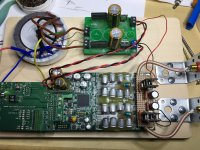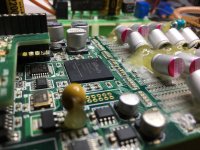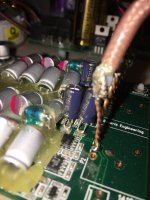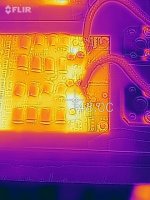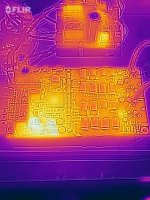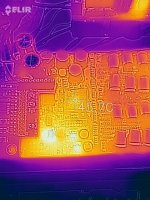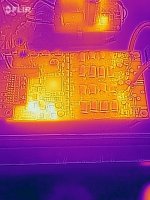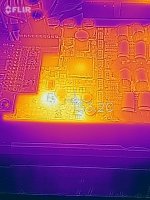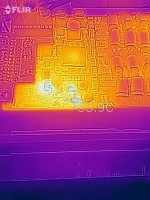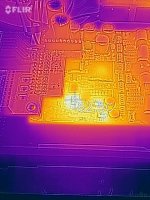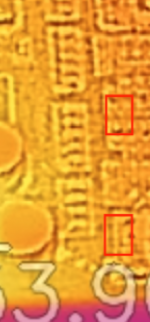I made some experiments on canceling the distortion of the DAM on the software side (see post4739347) but not with that much success as you. Also I forgot to take the voltage source resistance into account.
How did you estimate the errors?
How did you estimate the errors?
Hello TNT,
no, if the 2Hz filter nor the upsampling filter has changed the distortion, it is the hardware in the DAC to the other software outside the DAC. Surely you could insert the software change in the DAC, but that can only Sören.
Greetings JJ
OK! I see your picture of the hardware but I'm not familiar with this model. I see a diod that look like a mod... but else?
Congrats to your improvement - well done!
//
My current implementation.
Two LT1086 regs set to output 2 x 11V.
1,2nF LPF CG0 capacitors replaced with polystyren.
Output with discrete jfet opamps with ~10dB gain.
I have added a small layer of wax over r-2r resistors. This will protect against oxidation.
Regards,
Tibi
Two LT1086 regs set to output 2 x 11V.
1,2nF LPF CG0 capacitors replaced with polystyren.
Output with discrete jfet opamps with ~10dB gain.
I have added a small layer of wax over r-2r resistors. This will protect against oxidation.
Regards,
Tibi
Attachments
Last edited by a moderator:
What is the problem with surface oxidation?
//
In time solder may oxidate, copper traces may oxidate, resistors may loose tolerance due oxidation. Of course this depends on the air humidity, temperature etc.
It is just a precaution form my side to preserve good operation of this excellent dac.
Regards,
Tibi
OK - but I really wonder of oxidation is a problem... But reducing vibration + reducing temperature gradients is probably good. Did you also cover the oscillator?
//
//
If you use default output stage and wanna good and full bass, here is a mod that will make a huge difference.
Decouple output stage with 100uF/16V. I used Panasonic FC. Rubbicon ZA can be also a good candidate.
Regards,
Tibi
Decouple output stage with 100uF/16V. I used Panasonic FC. Rubbicon ZA can be also a good candidate.
Regards,
Tibi
Attachments
OK - but I really wonder of oxidation is a problem... But reducing vibration + reducing temperature gradients is probably good. Did you also cover the oscillator?
//
In time, oxidation may by a problem on any circuit.
Wax is an exceptional dielectric and thermal isolator.
For the time been only r-2r is covered in wax.
Regards,
Tibi
Last edited by a moderator:
What do you call the "default" output stage? The raw or the balanced op-amp based?
//
I'm decoupling opamps, therefore balanced and unbalanced output will get super bass. This mod will not improve RAW.
Regards,
Tibi
Last edited by a moderator:
OK - but I really wonder of oxidation is a problem... But reducing vibration + reducing temperature gradients is probably good. Did you also cover the oscillator?
//
About temperature gradients. Few FLIR pictures indicate no issues on R-2R network.
Regards,
Tibi
Attachments
Last edited by a moderator:
Hello JJ
I run two dam1021 improving the DEQX. One does the mids (70-1100Hz) and the other one all above 1100Hz. In theory there should be little or no sonic impact at all from a 2Hz IIR-HP. In praxis removing the IIR is best described by cleaning a painting:

source: https://www.museenkoeln.de/portal/medien/img_bdw/hi/2009_24a.jpg
Thanks.
Ulli
Thanks!Worth mentioning is the profit from the removal of the 2 Hz IIR high-pass filter.
I run two dam1021 improving the DEQX. One does the mids (70-1100Hz) and the other one all above 1100Hz. In theory there should be little or no sonic impact at all from a 2Hz IIR-HP. In praxis removing the IIR is best described by cleaning a painting:

source: https://www.museenkoeln.de/portal/medien/img_bdw/hi/2009_24a.jpg
Thanks.
Ulli
Thermal camera resolution is only 80 x 60 pixel.but it is probably very sensitive.
Each other is software interpolation up to the "normal" camera's picture.
Thermal camera resolution is only 80 x 60 pixel.
Each other is software interpolation up to the "normal" camera's picture.
I use a flirone camera. Resolution is 160 × 120 pixel and temperature 0.1°C.
If you know resistors ppm tolerance and temperature variation across R-2R network, you may calculate resistor variation.
Vishay - Change Of Resistance Due To TCR Calculator
Regards,
Tibi
pure DSD path...
I thought the DAM can work with DSD in - DSD through the DAM and DSD out. Without touching PCM! If you don't touch the volume control.
DimDim sais that there is no full DSD only path through the DAM.
I ask for definitive clarification. What is the DSD way through the DAM?
Thank you
The DAMs, being R-2R devices, need to convert DSD to PCM to make sound. Disabling the digital volume control will not help with that. There can be no "pure DSD path" with R-2R dacs.
I thought the DAM can work with DSD in - DSD through the DAM and DSD out. Without touching PCM! If you don't touch the volume control.
DimDim sais that there is no full DSD only path through the DAM.
I ask for definitive clarification. What is the DSD way through the DAM?
Thank you
I am sure you have read soekris' website
Soekris Engineering ApS, Products
Soekris Engineering ApS, Products
But what about the newer DSD recordings ? DSD is basically that you move the main part of a Delta Sigma converter from the player to to recording process, which still have all the disadvantages of the Delta Sigma processing.... It might improve over the old 16 bit / 44100 samples per second of the CD player, but can't beat a good high resolution PCM recording. We have choosen to support DSD recording as sometimes it is the only available format for a recording. A DSD player is basically a low pass filtering of the DSD bitstream, and we are doing the DSD to PCM conversion in a perfect digital process so you still can take advantage of our DAC quality and even use the perfect digital volume control.
Thanks for sharing the passage.
Too bad. Then the pure DSD path is probably a technology, which is reserved for the current DAC implementations.
We don't need to talk about the pros and cons or the audibility here. It was a matter of fact. And this means that the DAM cannot do pure DSD.
Too bad. Then the pure DSD path is probably a technology, which is reserved for the current DAC implementations.
We don't need to talk about the pros and cons or the audibility here. It was a matter of fact. And this means that the DAM cannot do pure DSD.
In "historical" reports you could read that the DAM made distinct noises when switching on and off, but also when changing to resolution in the source audio material.
Are all (!) this past and fixed?
I plan to use the DAM 1021 / 1121 with a DCG-03 as the output stage feeding three amplifiers.
And I have no interests to destroy my activ speakers or frighten me every time. ;-)
Are all (!) this past and fixed?
I plan to use the DAM 1021 / 1121 with a DCG-03 as the output stage feeding three amplifiers.
And I have no interests to destroy my activ speakers or frighten me every time. ;-)
- Home
- Vendor's Bazaar
- Reference DAC Module - Discrete R-2R Sign Magnitude 24 bit 384 KHz
